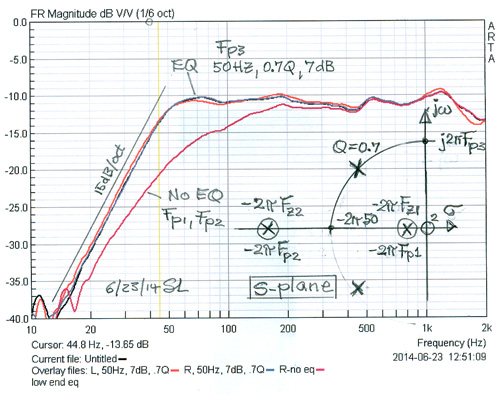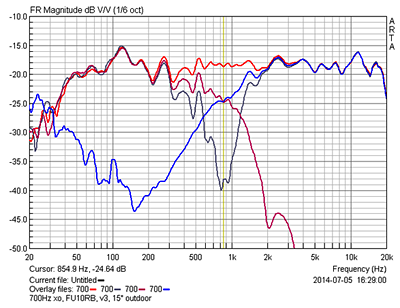|
A physically small loudspeaker
has limited air volume displacement capability, which determines how much low
frequency sound pressure can be generated. PLUTO has struck a nice balance
between size and bass output. PLUTO is an acoustic point source, a monopole, at
low frequencies, illuminating the room in all directions equally. At least the
center of the source is at ear height for a seated listener and bass is not
reinforced by the floor, but immediate surroundings will have some effect, if
they are close. That is unavoidable.
If a dipole point source is added to a monopole then
unidirectionl or cardioid radiation is obtained when both sources contribute
equally to the total sound. Here I use a 700 Hz LR2 crossover between monopole
and dipole. The dipole consists of a small full-range driver mounted above the
woofer section. Due to the transition from monopole to dipole radiator the
cardioid polar response is only obtained around the crossover frequency. At
higher frequencies the dipole radiates equally well to the rear as to the
front.
The rear radiation from the dipole must be attenuated or
scattered and diffused in order to minimize the influence of a large reflecting
surface behind the dipole radiator. The cylindrical body behind the dipole driver serves that
purpose as its dimensions are in the fractional wavelength range of the
frequencies concerned. There is a small gap between the magnet and the inside of
the pipe. The rear is open and stuffed with absorbent material for very high
frequency attenuation. The resulting polar response in
the horizontal plane is shown below. The response in the vertical plane should
be similar, because of closeness of the acoustically small sources. Thus a
listener's ears should be on the dipole axis. Standing upright close to the
speakers definitely darkens the timbre.
At 180 degree in the rear, the speaker has a small bright
spot between 1.2 kHz and 6 kHz. I have not noticed anything audible. Toe-in of
the speakers should throw any specular reflection off to the sides. The
resulting polar response of the LXmini is omni-directional at low frequencies.
It is an acoustic point source because the woofer driver and the pipe end are
small compared to the radiated wavelength. The radiating surfaces of woofer and
fullrange are at right angle to each other so frequency-modulation (Doppler)
distortion is very low, unlike that of a coaxial driver arrangement. The radiator remains acoustically
small through the crossover frequency range, where woofer and open baffle
tweeter form a cardioid polar pattern around the tweeter axis. In the tweeter
frequency range the radiation is dipolar, but with the rear radiation dispersed
irregularly and gradually attenuated with increasing frequency. The pattern is
formed by coaxial monopole and dipole sources. Thus the power response starts
out at 0 dB for low frequencies and decreases by 4.8 dB for cardioid and dipole
ranges and decreases further in the kHz range, but not as much as for the
typical 2-way box speaker. The timbre of the reverberated sound field changes
smoothly with frequency. Tonal neutrality, clarity and stereo imaging of the
LXmini are truly exceptional.
 |
The woofer sits at the
top of a sealed pipe, which is so heavily stuffed with absorbent material
that the two poles of the woofer highpass become real and roll-off is at
less than 12 dB/oct. The stuffing attenuates higher frequency pipe
resonances and stiffens the restoring force to the driver. The driver cone
undergoes large displacements, the electro-mechanical structure is
non-linear and the large amount of mechanical damping is thought to
stabilize the response.
The two real axis poles above and below Fb are
compensated by two zeros so that the complex pole pair determines the
roll-off characteristic. Equalization is done empirically with the DSP.
The actual roll-off rate is 15 dB/oct, which is close enough to a 12 dB/oct
theoretical behavior. |
Equalization is achieved by a 7 dB peak in the frequency
response of the DSP. This form of equalization is advantageous because the
response drops below 50 Hz towards 0 dB, thus relieving the driver somewhat of
excessive excursions below the peak frequency. The equalized woofer response is
3 dB down at 45 Hz.
Any DSP unit has limited analog input and output
capability. For the processor used the maximum Full Scale input and out voltages
are 900 mVrms. The power amplifier in this example
takes a 900 mVrms input to reach full 80 W of output power into 8 ohm. Looking
at the equalization curve and the signal level diagram we see the following
limitations:
- The power amplifier requires 900 mVrms or 2.54 Vpp
input voltage for 80 W output. This input voltage is also the output limit
for the DSP DAC. The corresponding 50 Hz input signal to the ADC is 7 dB
lower or 1.13 Vpp. This is 7 dB below the 2.54 Vpp input limit of the
ADC.
- A (2.54 - 1.13) = 1.41 Vpp sinewave at 5 kHz could be
riding on top of the 1.13 Vpp, 50 Hz sinewave, when the ADC input and the
woofer DAC clip.
- The 1.41 Vpp, 5
kHz sinewave signal would produces a 16 W output for the dipole fullrange,
if the tweeter channel had 0 dB gain. At -10 dB of gain the output is merely
1.6 W. A single 5 kHz sinewave at the clipping level of the ADC would
deliver 8 W to the fullrange.
The spectrum between 50 Hz and 10 kHz is evenly divided on
an octave basis by a 700 Hz crossover. Having 5 dB to 10 dB less peak signal
capability for the upper frequency range is of some concern to me. Putting 10 dB
of gain between DSP and power amplifier would make full use of the amplifier's
capability and raise the noise floor, which is of little concern. But after many
hours of listening to the LXmini I have only run into the expected woofer driver
excursion limitation. So I am happy. The drivers are the limiting elements and not the
electronics.
The range of the miniDSP 2x4 input ADC is set to 0.9 Vrms
by default. It can be increased to 2 Vrms by resetting two internal jumpers in
case a multi-channel volume control is used downstream of the miniDSP 2x4.
 |
The LR2 crossover results in
wide overlap between drivers from 300 Hz to 2 kHz, and they combine as two
point sources, being acoustically small. The electrical LR2 crossover
filters are set to 700 Hz, but the resulting acoustical crossover -6 dB
frequency is at 855 Hz due to the underlying equalization of each driver.
Tweeter channel delay is only 60 microseconds (21 mm). The tweeter has
no baffle and sees the woofer essentially in the radiation null. The deep and wide shape of the interference notch, when the polarity of
one driver is reversed, and the driver roll-offs, are indicative of the
well behaved vector addition of woofer and tweeter outputs when the normal
polarity is in play.
The on-axis frequency response extends to 20 kHz after equalization. The
full-range driver cone operates in break-up mode. I rely on the proven
consistency of SEAS drivers to be confident that my speaker design results
are transferable.
Ripples in the measured response below 1 kHz are due
to nearby reflecting objects. Interfering low frequency wind noise is seen
in the cut-off region of the tweeter. |
|